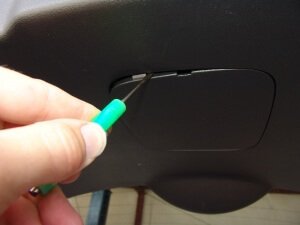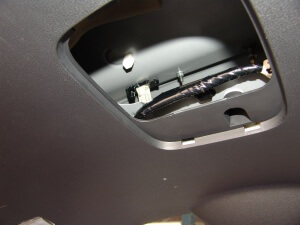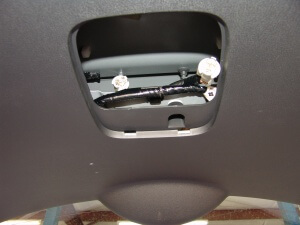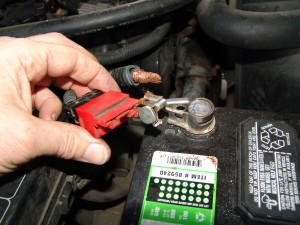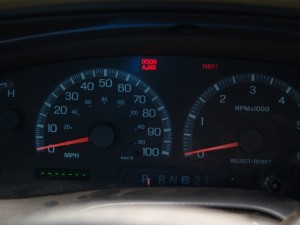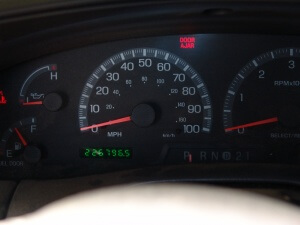This 2010 Buick Enclave CXL came in with the complaint that the a/c is not as cold as it should be during the heat of the day. The problem is that with the ambient temperature being 98° F and the heat index at 112°F the best the vent temperature would drop to was the mid fifties. This was after ten minutes of driving at 50mph. Granted that feels pretty good compared to the outside air, but it is not what should be expected from a late model GM vehicle.
This repair will generally apply to:
- 2008-2015 Buick Enclave
- 2009-2015 Chevrolet Traverse
- 2007-2015 GMC Acadia
- 2007-2010 Saturn Outlook
This Buick Enclave has automatic a/c controls as can be seen in the next picture. I noted that pressing the recirculation button made no audible change in the sound of the blower motor. Typically on any vehicle the sound of the blower motor should get significantly louder when the air flow is switched from fresh air to recirculation.
Checking the HVAC codes with my Tech 2 found a code B0228 symptom 61 , recirculation position feedback circuit actuator stuck. I cleared the code and tried to command the actuator to move to no avail. The actuator was indeed stuck. A little trick to determine if there is a problem with the control head or the wiring is to disconnect the actuator and see if the code changes. If it does, it at least suggests that the control head is active to changes in the circuit beyond the code that had been previously stored. The wiring also has to be generally intact for the same reason. The code did change so I proceeded to replace the actuator.
The actuator is located behind and to the left of the glove box.
I started by removing the push pin clips that hold the lower hush panel to the underside of the dash. I used a small screwdriver blade to pry the center pin from the fastener.
Once the pin is pulled to this general position the whole fastener can be removed from the dash.
There are two push pin fasteners that hold this panel in place.
Opening the glove box reveals the stop pins on both sides of the glove box interior.
They rotate to the left and slide out of the glove box wall.
There is a rod on the right hand side in addition to the stop pin. I would recommend supporting the glove box door as you release the rod from the gear mechanism.
Once the glove box door has opened completely the right hand side can be lifted up and off of the hinge pins. It is a little snug and takes some effort to release it.
The recirculation or air inlet actuator is just to the left of the blower motor and what looks to be slot for a cabin air filter. I could not get the right angle in order to see it in a picture.
It took both hands working through the openings to remove the three t20 torx bit screws that attach the acuator to the inlet door housing.
I used a two inch T20 bit with a 1/4″ ratcheting wrench to remove the screws.
Just in case you were wondering the actuator that you can see through the openings is the passenger side temperature door actuator. On this vehicle they are both the same part number.
There is also a wiring harness connector that has to be disconnected. I had to feel around for it and there was definitely no way to see it well enough to get a picture. Be careful when actually sliding the actuator off of the door shaft. There appears to be a white piece of plastic that connects between the actuator and the actual door shaft. On this vehicle it appeared to slide out a little bit and gave the impression that it can come all of the way out and allow the door to drop down out of position. That would be real bad and would take hours to rectify. My advice is that it is better to be safe than sorry.
The old part on the right and the new part on the left. The old part had part numbers T3983001 and 010100841B. The new part had numbers T3983001 and 010141912A. You can purchase the part by clicking here.
When reinstalling the glove box the translucent part that I am holding has to be rotated down so that the rod will align with the slot.
After the actuator was installed and recalibrated the vent temperatures were now staying between 42° F and 46° F. Earlier I mentioned that there should be a substantial change in the fan noise as it is switched between fresh air and recirculation. On this vehicle the difference is there but it is minimal.
I of course used my scan tool to perform the recalibration but if you do not have one here is the procedure.
- Begin with the ignition Off.
- Remove the HVAC/ECAS 15 amp fuse for at least 10 seconds. The fuse is located in the interior fuse box.
- Install the HVAC/ECAS Fuse.
- Start the engine and immediately put your hands in your pockets.
- Wait at least 40 seconds for the HVAC control module to self calibrate. I recommend 50 -80 seconds.
- Turn the ignition off for at least 10 seconds but no more than thirty seconds. Restart the engine and check HVAC operation.
- If no problems were encountered by the HVAC module during this process the recalibration is complete.




















































































